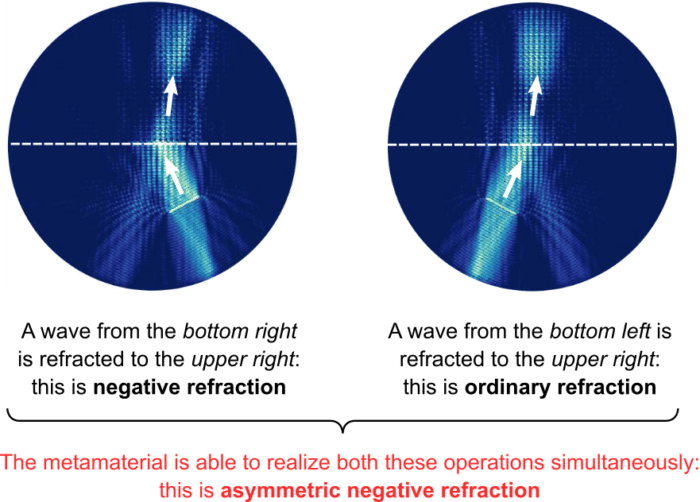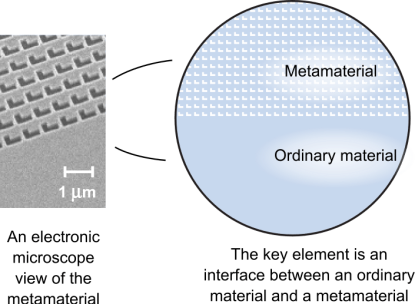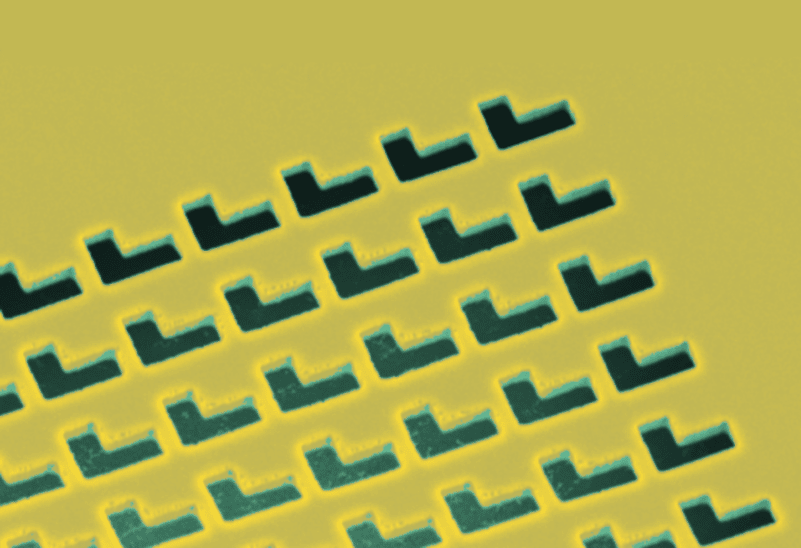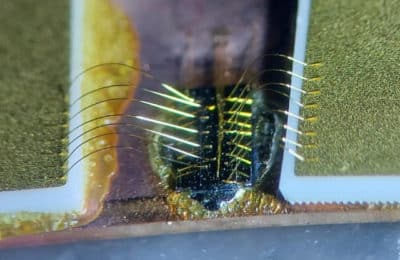Known examples of negative refraction in metamaterials do not distinguish between positive and negative angles of incidence. A group of scientists led by Cnr Nano have shown that it is possible to break this symmetry using a simple design, and demonstrate it using a mechanical metamaterial working at GHz frequencies. The study, published in Nature Communications, is another step towards the control of GHz mechanical waves and can help the evolution of the modern technologies based on GHz nanomechanics.
In recent years it has been possible to overcome the limitations of ordinary materials by means of the so-called metamaterials, which consist of arrangements of small elements, artificially fabricated with special shapes, such that their properties are not found in usual materials. Now Alessandro Pitanti and Simone Zanotto from Cnr Nano in collaboration with Istituto Officina dei Materiali Cnr and the Paul Drude Institute have engineered a new metamaterial showing a not-yet-observed phenomenon, that was given the name of asymmetric negative refraction.
When entering specifically structured metamaterials, light beams and waves undergo negative refraction. However, presently known negative refraction systems are symmetric, in that they cannot distinguish between positive and negative angles of incidence. In the new paper, researchers demonstrate that the symmetry of this property can be broken, as illustrated by Simone Zanotto: “When a wave is incident obliquely on the metamaterial, it will cross the interface and proceed bent in the same side from where it arrived. This is called negative refraction. The metamaterial we’ve engineered shows an even more exotic behaviour: it behaves differently depending upon the side from where the wave arrives – be it from the left or from the right”. Waves are hence refracted in negative way when coming from a side and in ordinary way when coming from the other one (see figure 1) .

Researchers obtained this strongly unusual phenomenon using an extremely simple material design: an array of L-shape holes arranged in a square lattice and etched in a gallium arsenide layer. The new metamaterial has been realized through advanced nanofabrication techniques by Simone Zanotto starting from materials grown by Giorgio Biasiol at Cnr Iom laboratories. It has then been tested using mechanical waves, whose exotic behavior was predicted by finite-element simulatons run by Alessandro Pitanti. Experimental characterization has been performed in collaboration with Paul-Drude-Institut in Berlin, where the research group of Dr. Paulo Santos has a world-leading expertise in the measurement of high-frequency mechanics of solid-state systems.
Even though the manipulation of mechanical waves with metamaterias have already been investigated, most experiment focus on frequencies spanning from Hz to mega Hz range. The team decided to raise the technical level aiming at operation at higher-frequencies with gigahertz (GHz) waves, that are relevant in fields such as the modern 4G and 5G technologies as well as the emerging quantum communication systems. The use of high frequency mechanical resonators as a novel platform for thermomechanical near infrared detectors can be also foreseen. “Our research demonstrated that negative refraction, augmented with the asymmetric character, can be operated also for low-frequency mechanical waves”, specifies Simone Zanotto, “In principle, by a simple rescaling of the metamaterial it could be applied, for instance, even for the deviation of meter-long seismic waves in order to protect buildings”. “Another horizon is that of incorporating quantum emitters/detectors – in that way, our systems could play an important role in the future quantum communications and computation platforms”, Simone Zanotto concludes.

Zanotto S., Biasiol G., Santos P.V. & Pitanti A., Metamaterial-enabled asymmetric negative refraction of GHz mechanical waves. Nat Commun 13, 5939 (2022). https://doi.org/10.1038/s41467-022-33652-8



